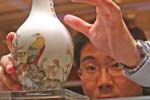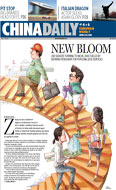Share Your Experience
Haunting beauty of the Huashan
Updated: 2011-03-05 07:37
By Zhao Shijun (China Daily)
Abode of immortals
In ancient times, the height of the mountain was also something emperors and officials considered when selecting a mountain to worship.
Rising about 1,800 meters abruptly from the Weihe Plain, which is around 300 meters above sea level, the height of the Huashan inspired the vivid imaginations of many.
Ancient people believed high mountains were places near heaven and the abode of immortals, so the Huashan no doubt must be sacred, a belief manifested in the area's many Taoist temples.
|
Western Mountains Temple was the site for sacrificial offerings by 56 emperors. Wang Chenggang / for China Daily |
China's native religion, Taoism highlights the pursuit of immortality.
Adherents believed pursuing freedom from worldly worries through meditating on tao - or universal rules - in a serene environment offered a path to immortality, so a number of Taoist temples were built on top of mountains.
The most famous are Yuquan Garden, Jintian Palace and Zhenwu Palace.
The Yuquan, also called Quanzhen Temple, has been the center of the Taoist Quanzhen sect for nearly a thousand years.
The founders of Quanzhen Taoism are today usually remembered as great kungfu masters skilled in martial arts.
The Jintian is a place to worship Shaohao, or the White Emperor, who ruled the western regions of ancient China as the contemporary of the Yellow Emperor some 5,000 years ago. They are considered the co-founders of the nation.
Like the Taoists, emperors also expected to live an everlasting life, but obsessed with worldly affairs, they resorted to other means - asking the Taoists, many of whom were alchemists, to find elixirs of immortality.
Atop the western peak, a small pond just 2 square meters in size and 1 meter deep is part of the legend - it never dries up in drought, yet never fills higher in rainy times.
Lao-tzu, the founder of Taoism, is said to have used its waters in an immortal potion.
|
Sun rising over a sea of clouds is a specutacular sight. Meng Hong / for China Daily |
Tips on travel
The best time to visit the Huashan is from April to October.
On the 15th day of the third month on lunar calendar, which is usually in April, a grand ceremony is held to worship heaven, the mountains and the gods. Today the event still draws tens of thousands of participants.
Legends say the event started 5,000 years ago when the Yellow Emperor and his successors offered sacrifices to the Huashan. Historical documents record the activities as early as in the Zhou Dynasty about 3,000 years ago.
Temple fairs, parades, acrobatic shows, folk songs and dance performances, are held in conjunction with the ceremony, allowing tourists to experience local culture and traditions.
It is often rainy and foggy in spring, but that is the best time to see the blossoming wild flowers.
Summer clouds ring the middle of the mountains, providing a spectacular sight from the summits of the sun rising above a sea of clouds.
The Huashan in autumn features clear days and rich colors of changing tree leaves.
It's not advisable for most tourists to climb into the high mountains in winter, but they can enjoy views of the snow-covered peaks.
In addition to sightseeing, travelers can also buy local handicrafts such as paper-cuts, shadow puppets and embroidery.
Huashan is about 120 kilometers from Xi'an and 140 kilometers from Xianyang International Airport, making access easy by plane, by train or by car.
Unlike the ancient people, visitors can now reach the main peak by riding a cable car, but it is strongly recommended to hike. Arduous as it is, the trip ensures tourists won't miss the essential sights or experiences.
E-paper

Green light
F1 sponsors expect lucrative returns from Shanghai pit stop
Buying into the romance
Born to fly
Light of hope
Specials

Share your China stories!
Foreign readers are invited to share your China stories.

No more Mr. Bad Guy
Italian actor plans to smash ‘foreign devil’ myth and become the first white kungfu star made in China.

Art auctions
China accounted for 33% of global fine art sales.


